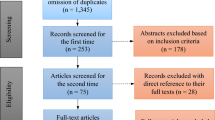Abstract
The National Science Teachers Association (NSTA) recently launched a comprehensive electronic professional development (e-PD) online portal, the NSTA Learning Center. This support site for educators currently includes over 6,000 e-PD resources and opportunities available on-demand, as well as various tools designed to help educators maximize the effectiveness of using NSTA resources. One tool, the PD Indexer, helps teachers identify their own areas of content strengths and weaknesses by selecting content-specific assessments. Individual NSTA resources are recommended based on assessment outcomes. This paper presents a detailed description of the procedures employed by NSTA to develop valid and reliable PD Indexer content-specific multiple-choice assessment items.




Similar content being viewed by others
References
Abell, S. K. (2007). Research on science teacher knowledge. In S. K. Abell & N. G. Leaderman (Eds.), Handbook of research on science education (pp. 1105–1149). Mahwah, NJ: Lawrence Erlbaum Associates.
America COMPETES Act, H.R. 2272, 110th Congress, 1st Session, (2007).
American Association for the Advancement of Science. (1993). Benchmarks for science literacy. New York, NY: Oxford University Press.
Anderson, T. (2003). Getting the mix right again: An updated and theoretical rationale for interaction. International Review of Research in Open and Distance Learning, 4(2). Retrieved April 29, 2009 from http://www.irrodl.org/index.php/irrodl/article/view/149/708.
Appleton, K. (2007). Elementary science teaching. In S. K. Abell & N. G. Lederman (Eds.), Handbook of research on science education (pp. 493–535). Mahwah, NJ: Lawrence Erlbaum Associates.
Bashaw, W. (1991). Assessing learner performance. In L. Briggs, K. Gustafsen, & M. Tillman (Eds.), Instructional design: Principles and applications (pp. 151–167). Englewood Cliffs, NJ: Educational Technology Publications.
Bransford, J. D., Brown, A. L., Cocking, R. R., Donovan, M. S., & Pellegrino, J. W. (Eds.). (2000). How people learn: Brain, mind, experience, and school. Washington, DC: National Academy Press.
Council of Chief State School Officers. (2007). Fifty-state analysis of the preparation of teachers and conditions for teaching: Results from the NCES schools and staffing survey. Washington, DC: Blank, R. K., & Toye, C.
Crocker, L., & Algina, J. (1986). Introduction to classical and modern test theory. New York, NY: Holt, Rinehart, and Winston.
Darling-Hammond, L. (2006). Constructing 21st-century teacher education. Journal of Teacher Education, 57, 300–314.
Dick, W., Carey, L., & Carey, J. O. (2008). The systematic design of instruction (7th ed.). Upper Saddle River, NJ: Merrill.
Educational Testing Service. (2009). ETS Guidelines for fairness review of assessment, Princeton, NJ. Retrieved April 29, 2009 from http://www.ets.org/Media/About_ETS/pdf/overview.pdf.
Fishman, B. J., Marx, R. W., Best, S., & Tal, R. T. (2003). Linking teacher and student learning to improve professional development in systemic reform. Teaching and Teacher Education, 19, 643–658.
Gagne, R., & Driscoll, M. (1988). Essentials of learning for instruction. Englewood Cliffs, NJ: Prentice Hall.
Goldhaber, D. (2002). The mystery of good teaching. Education Next, 2, 50–55.
Griffith, G. (2008). Initial impacts of no child left behind on elementary science education. Journal of Elementary Science Education, 20, 35–48.
Hambleton, R. K., & Rodgers, H. J. (2004). Developing an item bias review form. ERIC Doc: ED398241. Clearinghouse on Assessment and Evaluation. Retrieved April 29, 2009 from http://ericae.net/ft/tamu/biaspub2.htm.
Hanuscin, D. L., & Lee, M. H. (2008). Using the learning cycle as a model for teaching the learning cycle to preservice elementary teachers. Journal of Elementary Science Education, 20, 51–66.
Heywood, D. S. (2007). Problematizing science subject matter knowledge as a legitimate enterprise in primary teacher education. Cambridge Journal of Education, 37, 519–542.
Howitt, C. (2007). Preservice elementary teachers’ perceptions of factors in a holistic methods course influencing their confidence in teaching science. Research in Science Education, 37, 41–58.
Kang, N. (2007). Elementary teachers’ epistemological and ontological understanding of teaching for conceptual learning. Journal of Research in Science Teaching, 44, 1292–1317.
Luera, G. R. (2005). What type and level of science content knowledge of elementary education students affect their ability to construct an inquiry-based lesson. Journal of Elementary Science Education, 17, 12–25.
Merrill, M. D., & Tennyson, R. (1994). Teaching concepts: An instructional design. Englewood Cliffs, NJ: Educational Technology.
Mundry, S. (2005). Changing perspectives in professional development. Science Education, 14, 9–15.
National Research Council. (1996). National science education standards. Washington, DC: National Academy Press.
Nunnally, J. (1967). Psychometric theory. New York, NY: McGraw-Hill.
Popham, W. J. (2008). Classroom assessment: What teachers need to know. Boston, MA: Pearson.
Sullivan, H., & Higgins, N. (1983). Teaching for competence. New York, NY: Teachers College Press.
U.S. Department of Education. (2000). Before it’s too late: A report to the nation from the national commission on mathematics and science teaching for the 21st century. Washington, DC: National Commission on Mathematics and Science Teaching for the 21st Century.
U.S. Department of Education, & National Center for Education Statistics. (2009). Common core of data (CCD), State nonfiscal survey of public elementary/secondary education, 2000–2001 through 2005–2006. Retrieved April 29, 2009 from http://nces.ed.gov/programs/digest/d07/tables/dt07_062.asp?referrer=list.
Weiss, I. R., Banilower, E. R., McMahon, K. C., & Smith, S. P. (2001). Report of the 2000 national survey of science and mathematics education (No. REC-9814246). Chapel Hill, NC: Horizon Research, Inc.
Wilson, S. M., Floden, R. E., & Ferrini-Mundy, J. (2002). Teacher preparation research: An insider’s view from the outside. Journal of Teacher Education, 53, 190–204.
Author information
Authors and Affiliations
Corresponding author
About this article
Cite this article
Byers, A., Koba, S., Sherman, G. et al. Developing a Web-Based Mechanism for Assessing Teacher Science Content Knowledge. J Sci Teacher Educ 22, 273–289 (2011). https://doi.org/10.1007/s10972-011-9227-2
Published:
Issue Date:
DOI: https://doi.org/10.1007/s10972-011-9227-2




